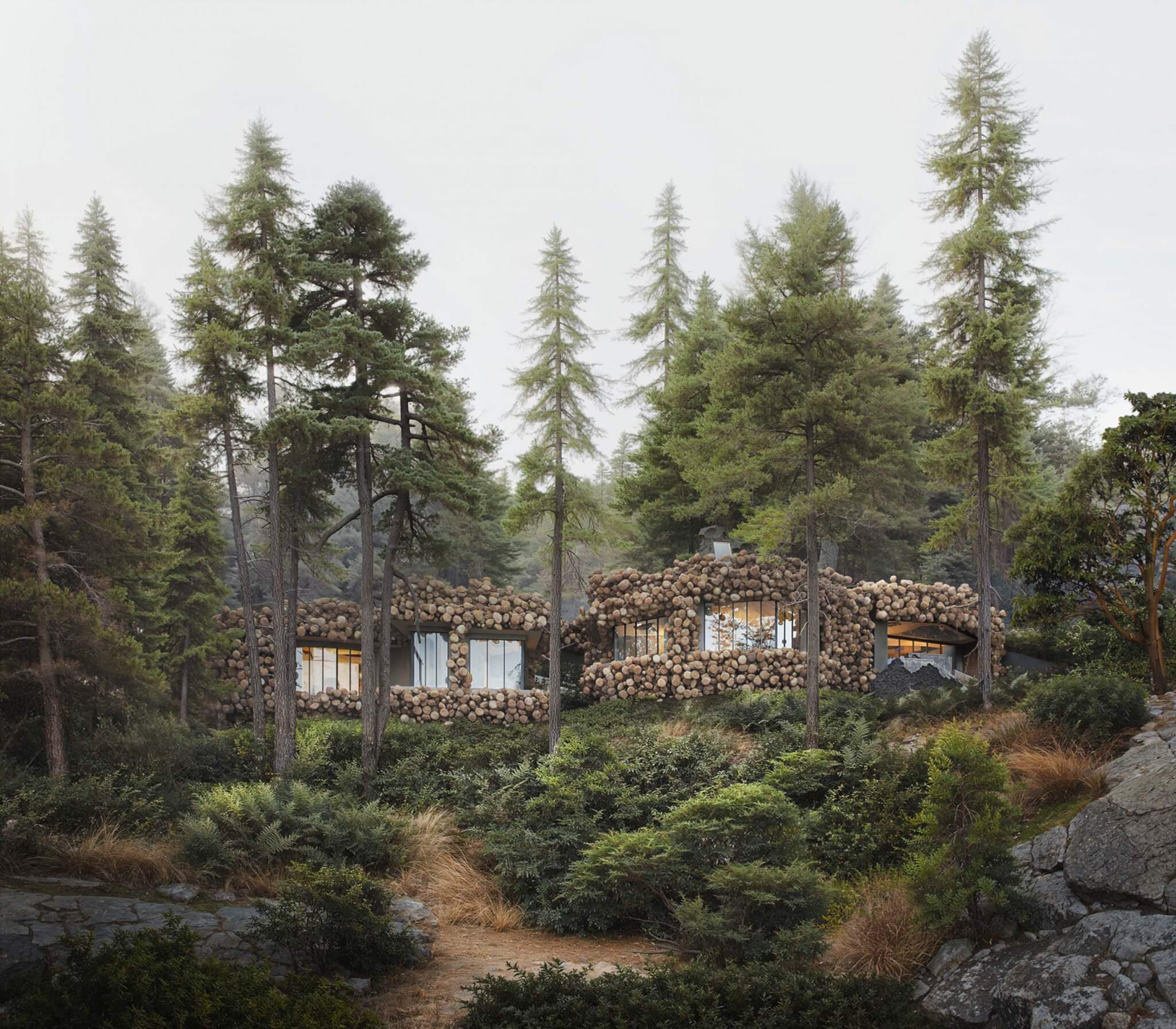Chuckanut Drive is a historic, scenic corridor between Vancouver and Seattle. There, up against the Salish Sea’s shoreline, overlooking the San Juan Islands, Omer Arbel Office has ideated 16 bespoke homes as part of a new planned community, Governors Point.
Governors Point is sited just south of Bellingham, Washington. The Vancouver-based firm said houses at the planned community were designed so that they won’t disrupt views from Chuckanut Drive of the sea. Toward that end, the new buildings will be tucked behind trees, private roads, gates, and other infrastructures. Purchase prices for the houses start at $4.4 million.
Each of the 16 luxury homes on Governors Point will have maximum living areas of 2,900 square feet, sited on 1.5 acre lots. Restrictions are in place that dictate only a small portion of the site—3,000 square feet per lot—can be manicured in the form of gardens or lawns.
Nestled with Nature
The remainder of the site, a short distance from Larrabee State Park, must be kept in its natural form as per an agreement between the owner, Randy Bishop, and Whatcom Land Trust, a group which manages the peninsula. Rand Jack, a founding board member of Whatcom Land Trust, called the agreement and accompanying design a “stunning gift to our community and beyond.”

Renderings of Governors Point reveal facades comprised of rocks and concrete. Interior spaces are carved away where the size of stones become voids, evoking stalactites, and caves. The change in grade from Chuckanut Drive to the parcels is substantial, so terraces step down to the coast in a serpentine manner, replete with shrubbery and plantings to make it blend in.
Wood and charcoal black floor tiles and finishes are used sparingly elsewhere at Governors Point, creating a moody milieu overlooking the sea. “The potential here is for the architecture and ecology of the sites on Governor’s Point to become one and the same,” Omer Arbel Office’s founder and creative director Omer Arbel shared in a statement.
“We are committed to conserving the land, in part by designing homes that will be enveloped by a veil of the landscape [and] building a contrast between the experience of intimacy and shelter on the one hand, and visceral exposure to the sublime site on the other,” Arbel added. “It’s with these goals in mind that we have iterated an intricate design language across the entire peninsula, which we expect to be emotionally transportive.”

Today, the peninsula slated for development is preserved and managed by the Whatcom Land Trust. The group was founded decades ago to preserve the peninsula’s untouched nature amid a major development wave that was engulfing much of Washington’s pristine shoreline.
There were a few attempts in years past to develop the land, most recently The Point at Governors Point, but those didn’t pan out thanks to community pushback, controversies, and litigation. But Whatcom Land Trust eventually found a developer that was sympathetic to its cause.
Randy Bishop, a Canadian business owner, purchased Governors Point in 2018 for $5.7 million. In 2023, Whatcom Land Trust reached an agreement with Bishop that preserved more than 75 percent of the peninsula’s nature reserve.
Conserving Governors Point
Bishop bought the land in bankruptcy court from Roger Sahlin, whose family owned Governors Point since the 1960s. Bishop as-of-right could have built 25 houses on the peninsula, but he chose to build just 16 instead so as to preserve more shoreline. This left 98 acres on the peninsula untouched by construction, land that was subsequently donated to Whatcom Land Trust.
The agreement also set the groundwork for a public trail to be built on the peninsula with beach access on the east and west sides of Governors Point. These beaches will be accessible via self-propelled kayaks, canoes, and paddle boards.
“Governors Point was frozen in time from years of controversies and litigation. It would surely be a typical subdivision project if not for this complicated past. The land demanded something different, something special,” Bishop said in a statement. “Over my 20-year partnership with Omer Arbel, he has taught me a lot about ‘site specificity.’ When he looks at an architecture project, the site gives birth to the idea.”

Bishop continued: “I applied this philosophy to Governors Point. All of the voluntary restrictions applied to the project, including limiting the home sizes, were in service of paying a high level of respect to the unprecedented quality of the land. Because the homes would be surrounded by a nature reserve and set alongside a pristine coastline frequented by kayakers, these elements drove the architecture brief—nestled and integrated into nature with a high priority on the waterside experience.”
“From an ecological and aesthetic perspective, the Governors Point peninsula is surely one of the finest undeveloped private properties in the U.S. Since its founding in 1984, Whatcom Land Trust has dreamed of finding a way to conserve this iconic piece of Whatcom County,” Rand Jack said. “The landscape is habitat for mature red cedar, Douglas fir, big leaf maple, hemlock, and grand fir trees, not to mention its views of the Salish Sea, natural sandstone, and saltwater beaches.”

The new homes are slated for completion in the next 6 to 10 years.

